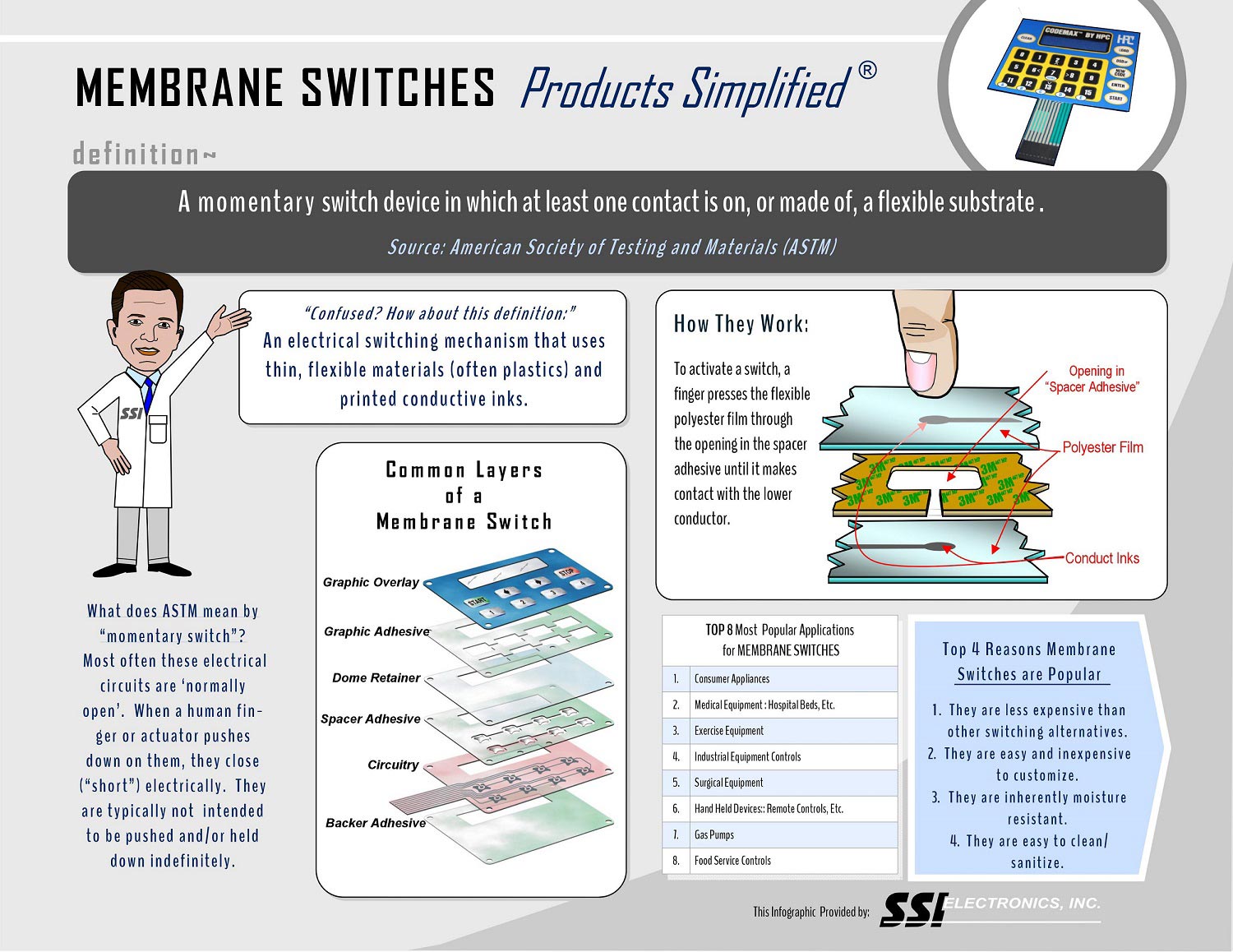Everything About Membrane Switch: A Comprehensive Guide for Beginners
Membrane layer buttons are necessary components in modern-day electronic devices, offering an one-of-a-kind interface for user interaction - membrane switch. Their split building and construction, consisting of overlays and conductive traces, offers functionality and longevity. Unlike traditional mechanical buttons, membrane buttons offer a sleek design and personalized choices. Comprehending their vital attributes and advantages can change product design. Nonetheless, the details of their application and layout considerations require more exploration
What Is a Membrane Switch?
A membrane layer button is a kind of electric switch that consists of an adaptable membrane layer layered over a printed motherboard. This layout allows for a sleek and portable interface, frequently made use of in numerous digital tools. Membrane layer switches are generally found in consumer home appliances, medical devices, and industrial machinery due to their toughness and resistance to environmental factors.The construction commonly consists of numerous layers, such as graphic overlays and glue support, which provide responsive responses and protect the wiring below. The operation of a membrane switch is initiated when pressure is put on the surface area, completing an electrical circuit.These switches are valued for their flexibility, enabling custom styles and printed graphics that deal with details interface. Their inconspicuous nature reduces room needs, making them excellent for applications where conventional buttons might not fit. On the whole, membrane switches use a aesthetic and practical remedy for modern electronic devices.
Trick Components of Membrane Changes
Membrane layer switches consist of several crucial parts that add to their functionality and performance. The top layer, called the overlay, provides the user interface and is frequently printed with signs or graphics. Under the overlay lies a spacer layer, which separates the conductive components and protects against unintentional activation. The following vital part is the graphic layer, which enhances looks and assures the durability of the design.Conductive traces, usually made from materials like silver or carbon, are printed on the circuit layer. When stress is applied to the overlay, these traces enter get in touch with, completing the circuit. Additionally, a backing layer provides structural support and can be made from materials such as polyester or polycarbonate. Together, these parts produce a trustworthy, easy to use user interface ideal for various applications, from home appliances to commercial devices. Recognizing these elements is crucial for any individual curious about membrane layer button technology.
How Membrane Layer Switches Work
Recognizing exactly how membrane switches over function is vital for valuing their extensive usage in numerous tools. A membrane button operates with a series of layers, including a visuals overlay, spacer, and a circuit layer. When stress is used to the overlay, it compresses the spacer layer, enabling the circuit layer to make contact and finish an electrical circuit. This action sends a signal to the tool, motivating a response, such as transforming on a light or activating a function.Membrane switches can be developed with various attributes, including tactile responses, backlighting, and custom-made graphics, enhancing customer communication. Their building and construction permits a sealed layout, protecting the internal elements from dirt, dampness, and impurities. This toughness makes them suitable for varied applications, from customer electronic devices to industrial devices. Overall, the simplicity and effectiveness of membrane layer switches over contribute to their popularity in modern innovation.
Benefits of Membrane Layer Switches Mechanical Switches
While mechanical switches have actually long been a staple in lots of devices, membrane layer switches over deal distinctive benefits that make them progressively appealing. One considerable benefit is their slim profile, enabling more compact layouts and better flexibility in item advancement. Additionally, membrane changes function an uniform surface, which enhances visual charm and simplifies cleansing, making them suitable for environments where health is critical.Another benefit is their resistance to dirt and dampness. Unlike mechanical buttons, which can be endangered by ecological aspects, membrane buttons give a covered user interface that safeguards versus impurities - membrane switch. Furthermore, membrane buttons usually have a longer life expectancy as a result of less relocating parts, leading to enhanced toughness and reliability.Cost-effectiveness is also a noteworthy advantage, as membrane layer buttons can be created in bulk with lower manufacturing expenses. These aspects integrate to place membrane switches as a functional option to typical mechanical options in various applications
Typical Applications of Membrane Layer Switches
Membrane buttons are commonly utilized in numerous sectors, especially in consumer electronics and commercial control panels. In consumer devices, they give a sleek, easy to use interface, while in industrial setups, they enhance sturdiness and performance. Recognizing these applications highlights the adaptability and practicality of membrane layer buttons in contemporary innovation.
Customer Electronics Devices
As customer electronics continue to advance, membrane buttons have actually become a popular selection for a range of gadgets because of their convenience and streamlined style. These switches are frequently found in mobile phones, tablets, and push-button controls, where room is restricted and looks issue. Their low account and adjustable layouts enable suppliers to develop straightforward user interfaces that improve the general user experience. In addition, membrane switches are frequently utilized in appliances such as microwaves and coffee makers, offering user-friendly control options while resisting wetness and dirt. The durability and dependability of membrane Get the facts layer switches over make them ideal for day-to-day consumer products, guaranteeing longevity and consistent efficiency. In general, their integration in consumer electronics shows a blend of performance and contemporary layout.
Industrial Control Panels
The applications of membrane changes extend past customer electronic devices, finding substantial usage in commercial control board. These buttons are favored for their toughness and resistance to extreme settings, making them optimal for producing and procedure control settings. They provide a reputable user interface for drivers to control machinery, display procedures, and change setups. Membrane buttons can be tailored to match certain operational demands, including attributes like backlighting and tactile feedback, improving individual experience. Their low-profile style enables combination into different equipment, while their capability to stand up to spills, dust, and extreme temperature levels assurances durability. In general, membrane layer buttons add to secure and efficient operation in industrial applications, demonstrating their adaptability and effectiveness popular settings.
Considerations for Creating Membrane Layer Switches
When developing membrane layer switches, picking the right products is vital to guarantee longevity and performance. Furthermore, recognizing layer configuration strategies can greatly affect the button's efficiency and individual experience. These factors to consider play a vital function in producing effective and dependable membrane button styles.
Product Choice Significance
Product choice plays a vital duty in the design and capability of membrane layer switches. The selected products directly influence the button's longevity, tactile feedback, and total aesthetic. Secret factors to consider include the substrate, which must offer architectural honesty while permitting versatility, and the graphic overlay, which needs to be immune to put on and ecological aspects. Conductive products ought to guarantee dependable electrical efficiency, while adhesives need to provide solid bonding without jeopardizing the button's operation. Additionally, compatibility with producing processes and end-user settings is essential; products must endure differing temperature levels, moisture levels, and chemical exposure. Inevitably, proper material selection not only boosts the membrane layer button's efficiency however also adds to its long life and user fulfillment, making it an important facet of the layout process.

Layer Arrangement Methods

Frequently Asked Inquiries
The Length Of Time Do Membrane Layer Switches Over Normally Last?
Membrane layer buttons typically have a life expectancy of 1 to 5 million cycles, relying on usage and environmental conditions. Variables such as style quality and operating frequency significantly influence their toughness and overall efficiency long life.

Can Membrane Changes Be Custom-made for Details Designs?
Membrane buttons can without a doubt be tailored to accommodate certain layouts, permitting for diverse shapes, shades, and performances. This flexibility allows producers to customize these buttons to meet special aesthetic and functional demands efficiently.
What Materials Are Made Use Of in Membrane Layer Switch Building?
Membrane layer buttons are generally constructed using materials such as polyester, polycarbonate, and sticky layers. These products offer resistance, longevity, and versatility to environmental factors, guaranteeing the buttons operate properly in different applications and problems.
Are Membrane Layer Switches Over Immune or waterproof to Dampness?
Membrane layer switches can be designed to be moisture-resistant, using specialized coverings and products. Nevertheless, their water-proof capabilities rely on construction high quality and certain applications, making it vital to evaluate demands for perfect performance in numerous atmospheres.
How Are Membrane Switches Over Repaired if Harmed?
Repairing damaged membrane layer changes generally involves replacing the affected layer or circuit. Professionals may additionally apply conductive sticky or utilize specialized repair work kits, making certain performance is recovered without total substitute of the entire switch assembly. Unlike typical mechanical buttons, membrane layer switches offer a smooth design and adjustable choices. A membrane layer button is a type of electrical switch that check my source consists of a flexible membrane layered over a published circuit board. The operation of a membrane switch is launched when stress is applied to the surface area, finishing an electrical circuit.These switches are valued for their flexibility, enabling personalized designs and published graphics that cater to particular user interfaces. While mechanical switches have actually long been a staple in lots of tools, membrane changes deal distinct benefits that make them increasingly appealing. Membrane layer switches typically have a longer life expectancy due to fewer relocating parts, resulting in boosted longevity and reliability.Cost-effectiveness is additionally a significant benefit, as membrane layer buttons can be generated in bulk with lower manufacturing costs.